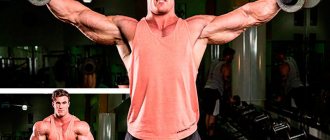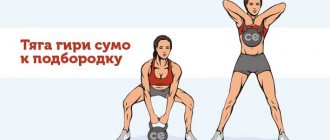The one-arm standing kettlebell press is a classic exercise that is used as a lead-in to the clean and jerk of the kettlebell. It strengthens the shoulder girdle. The exercise is used not only in kettlebell lifting itself, but also as an auxiliary exercise in bodybuilding and powerlifting. For aesthetic athletes, it helps pump up muscles from a different angle. Powerlifters – develop triceps and anterior deltoids for the bench press. The movement also trains coordination and balance. At the same time, it loads the musculoskeletal system less than vertical bench presses with a barbell.
Execution technique
Initial position
- The weight is taken from the floor;
- You need to stand up straight, mark the projectile firmly on the floor;
- Grab the handle with your hand;
- Perform a sharp extension of the legs at the knee and ankle joints;
- Take the projectile to your chest;
- Place your elbow under the handle of the weight;
- The handle lies in the palm of your hand so as not to cause pain or discomfort.
Movement
- Extend the elbow joint;
- The shoulder will also naturally straighten;
- Launch the projectile above your head;
- Direct it with its bottom towards the floor and behind your back;
- Lower onto your shoulder in reverse order.
Standing kettlebell press: technique [Sports Bro]
Attention
- The movement goes along the body; the forearm should not be placed perpendicular to the body;
- The arm is extended at the elbow joint first, then at the shoulder;
- The wrist should not be hyperextended;
- The press should not be performed by pushing with the legs;
- The body should not swing back and forth;
- During the workout, you should engage your core and glutes and stabilize your body;
- It is necessary to avoid rocking from heel to toe;
- The free arm can be extended slightly to the side and rigidly straightened for balance;
- You should not hold the handle of the weight on your fingers.
Safe starting and ending position
The starting and finishing positions of the one-arm press are safer than other popular shoulder strength exercises such as front and lateral raises. The long leverage of front and side lifts often forces the scapula away from a stable position at the beginning and end of the movement. This is similar to lifting a crane off the ground before lifting a load onto a tall building.
Frontal and lateral raises cause more shoulder problems than any other exercise by targeting the muscles that try to hold the shoulder blades in relation to the neck and torso (the trapezius and rhomboids)..
The main role of the scapula is to support the arm. It can move freely to maintain the correct position of the glenoid fossa in relation to the head of the humerus. With a winged scapula (the medial edge moves away from the rib cage or tilts forward), or the medial/superior part of the scapula is higher than the lateral part, which places the glenoid fossa in a position that limits arm elevation. This is wrong and not stable. In this position, the scapula loses the necessary orientation.
The one-arm press, on the other hand, offers the correct position. With one-arm presses, the scapula is dynamically stable, there is unlimited freedom of movement with situational support and maintaining the correct position.
The movement begins in a rack position, with the kettlebell directly in front of the shoulder. The weight is located on the forearm, on the outside of the hand clenched into a fist, with the elbow pointing forward. The palm of the hand is directed towards the face. In the final position, the kettlebell is strictly above the shoulder, the elbow is straight. Both of these positions, initial and final, stabilize the position of the scapula.
Recommendations
- Keep your hand in the same plane as your forearm, the handle of the weight rests on your palm;
- The fingers should not bear the entire weight of the projectile;
- You should not push off with your feet and straighten your knees;
- Presses should be in the same plane;
- You should not actively move your body weight from toe to heel;
- You need to start with adequate kettlebell weights. Many people only have the standard 12, 16, 24 and 36 kg at their disposal. If this weight doesn't suit you, check out CrossFit kettlebells;
- The movement of the kettlebell should not be jerked; the jerk amplitude is not practiced with pressure; this can lead to injury to the elbow joint;
- The body is kept fixed by holding the core and back muscles;
- At the top point of the amplitude, the arm should be fully straightened;
- Leaving your elbows slightly bent or holding the kettlebell handle on your fingers is not safe.
Double kettlebell swing
The double kettlebell swing is an effective exercise for gaining explosive power, strengthening the entire body, and developing an iron grip. This movement is mandatory not only for strength and power, it will also be the key to overall improvement of physical condition.
Performance:
1) pick up the weights, letting them hang between your legs; 2) with a swinging movement similar to an uppercut, synchronously pull the weights to the chest; they should end up between the biceps and forearm; 3) return the weights back to the position between your legs, do not impede their movement.
Advice. Make sure that the weights do not turn upside down; they only change their position during the uppercut.
Execution options
- Synchronized press with two hands - two weights are taken and the athlete presses them while standing, synchronously;
- Seated single kettlebell press - this option is chosen by those who have a strong shift to the side when doing a standing press and push with one leg. Begin this variation with strict technique and the least weight of weights that can be felt.
Standing kettlebell press. How to build powerful shoulders? Men's exercise with a kettlebell. Shoulder press, kettlebell.
Analysis of the exercise
What muscles work
- The main ones are the entire array of deltoids and triceps;
- Accessory muscles – core, biceps, latissimus dorsi and trapezius muscles
Advantages
- The exercise comprehensively develops the muscles of the shoulder girdle;
- Teaches how to assemble the body under weight, can be used as a special preparatory exercise for exercises with a barbell, both vertical presses and front squats;
- Works through all stabilizers;
- Develops the strength of the arms and shoulders evenly, helps get rid of natural distortions;
- Less traumatic for the shoulder and elbow joints than the classic military bench press;
- May help improve bench press results by developing triceps;
- Allows you to improve the functioning of the shoulder joint under load and its mobility.
Flaws
- Requires advanced dexterity skill. Kettlebells are a projectile with a shifted center of gravity; it will be difficult for a beginner to handle them;
- May not be safe if performed with serious technical errors;
- In poorly equipped gyms or at home, requires exceptional technical skills to progress the scales. Too large a step between the weights of the weights can provoke problems with increasing working weights.
Preparation for execution
Requires aerobic warm-up in a small volume and joint exercises with special attention to warming up the hands, shoulder joints and elbow joints. Warm-up sets can also be included in the plan; they should be performed with lighter weights. It can be performed with dumbbells if there are no lighter weights in the gym.
Proper execution
- The starting position should be taken with a tucked stomach and tense buttocks. The athlete's body weight is projected onto the middle of the arch of the foot, and not onto the toe or heel;
- The elbow can either rest on the side or remain suspended, the main requirement is not to shift the body weight too much to the side;
- The press starts with a smooth extension in the elbow joint; you should not push off from the side with your elbow;
- When starting, the body weight falls on the heels or the middle of the arch of the foot, but not on the toe;
- The kettlebell should not be actively thrown back; it should move along a natural trajectory;
- The handle of the projectile should be squeezed tightly with your fingers, the grip is closed;
- There is no need to rest the handle on your knuckles or fingertips.
Kettlebell PRESS RULES (competitions)
Technical errors
- Leg kicks, toes, knee extensions;
- Performing bench presses using the squat technique;
- Abduction of the arm to the side along with the projectile, distortion in the elbow and forearm;
Tips for Effective Execution
- The weights are taken from the floor using the squat technique. To do this, place the projectile between your legs, grab its handle with a straight grip, bend your knees and straighten your back. Then, due to simultaneous sharp extension in the hip and knee joints and flexion at the elbow, the weight is taken to the shoulder;
- Your feet can be placed a little wider or shoulder-width apart. With wider feet, the body position will be more stable;
- When lowering, slight bending of the knees is allowed, the so-called “cushioning”;
- Presses, like other unilateral exercises, require full concentration and should always be performed with the “weak” hand. Usually the left one is weaker, but it can be the other way around. Perform all repetitions with your weak hand, and then all repetitions with your strong hand;
- The handles of the weights can slip a lot. Typically, gymnastics or weightlifting magnesium is used to prevent this unpleasant effect and prevent calluses.
Inclusion in the program
- This is a strength exercise. It is performed for 5-8 repetitions in 3-4 approaches. It is usually included in the program as the main exercise for the shoulders, if we are talking about bodybuilding, or as a second or third exercise, if it is used to practice the pushing technique.
- Working in failure is not recommended. Most non-professional athletes will use their legs in this exercise if given such a task.
- The load should increase smoothly. If it is not possible to use a wider range of weights, you can use rubber. It will increase the resistance in the upper third of the exercise;
- Tires are selected individually. Girls start with elastic bands with a resistance of 10 kg, guys - 15 kg. You can also use smaller rubber bands, but it is advisable to use tourniquets rather than thick, wide elastic bands from fitness kits;
- Vertical presses with kettlebells can also be planned in such a way that most of the load is performed with a medium weight and a number of repetitions closer to 5-8, rather than in a low-rep mode. Some athletes perform the main volume with one arm, and then “finish off” with bench presses alternately;
- If the plan includes a standing barbell press, then perform it first, and then do weight presses in a reduced volume. If the athlete performs both presses, the anterior deltoid may not be performed in isolation; in general, it is recommended to compensate for the entire volume of the load with exercises on the posterior deltoid muscle.
Contraindications
- Not recommended for significant scoliosis, above grade 2. However, some athletes perform the exercise with lighter weights. This applies mainly to professional sports;
- Injuries to the hand, fingers, shoulder joint and arm should also be considered a contraindication;
- Strictly not recommended for lumbar hernias and hernias and protrusions in the thoracic region;
- It is better to replace it with standing forearm abductions during rehabilitation after rotator cuff injuries;
- It is not recommended for those who suffer from intercostal neuralgia or whose trapezius muscles are overloaded due to the presence of heavy pulls or shrugs.
Errors: what to look out for?
Errors are violations of the technique of performing an exercise, which can significantly affect training results. In general, the exercise is technically quite simple and the movement is easy to master.
Certain difficulties arise due to the fact that the kettlebell is not as balanced as a barbell or dumbbells. But this feeling disappears quickly enough if you practice the technique correctly.
Try not to make mistakes, as excessive overload can cause injury. Therefore, it is recommended to avoid the following mistakes:
Separately, it is worth noting once again how to breathe correctly. It is imperative to follow these rules so that your blood pressure does not increase:
Data
- An impressive result in the standing press belongs to the Russian athlete Peter Krylov. He pressed a 32kg kettlebell a whopping 86 times. It is believed that competitive athletes should train with this type of kettlebell;
- The kettlebell press was one of the exercises of competitive kettlebell lifting, but then it was excluded from the program due to lack of entertainment and too complex criteria for evaluating the technique;
- Kettlebell lifting guru in the West, Pavel Tsatsouline, believes that the standing kettlebell press is much more useful than the bench press of barbells and dumbbells. It engages both the upper chest and triceps, as well as the deltoids and promotes harmonious muscle development. In addition, the situation when you need to pick up something and put it on a shelf occurs much more often than when you need to do push-ups from the floor, for example, so standing kettlebell press helps prevent household injuries. This is especially useful due to the fact that we press while standing first with one hand, then with the other, and we also lift things most often with one hand;
- Adequate weights are selected depending on strength and body weight. Most people should start not with a third of their body weight, as sources recommend, but with a quarter or one-eighth. Fitness sources recommend that girls start training with a 4kg kettlebell and guys start with an 8kg kettlebell. Then progress accordingly to 8 and 16 and further, as the sports result increases.
Advantages of kettlebell presses[edit | edit code]
- Develops core and arm strength.
- Makes arms flexible and strong.
- Strengthens the abs and oblique abdominal muscles.
Let's list some not too ambitious, but quite realistic goals for an ordinary guy trying to develop strength:
- 200 snatches with a 24kg kettlebell for 10 minutes.
- Lift and press a weight of approximately half your weight with each hand.
The snatch develops a fighting spirit, develops endurance, gets rid of fat, develops a strong grip and powerful legs for hard strikes, and makes other people amazed at the strength of your handshake.
Pressing two heavy kettlebells builds your upper body. In some regions of Russia, benching a two-pound weight turns a boy into a man.
Here are the goals that girls should strive for:
- Do 200 snatches with a 12kg kettlebell for 10 minutes.
- Lift and press a kettlebell of about a quarter of your body weight once with each hand.
In order to reach this level of strength and endurance, it may take you a year or two, possibly more, there is no need to rush here. But when you reach your goal, your strength and endurance will amaze you, and you'll have muscles where you need them without a drop of fat. You will become so strong that you can proudly call yourself a man.











